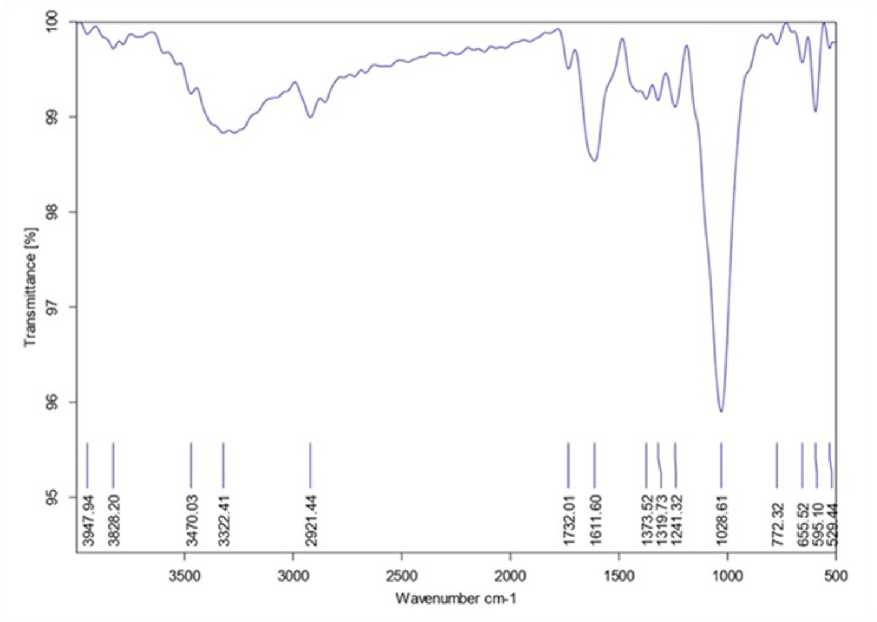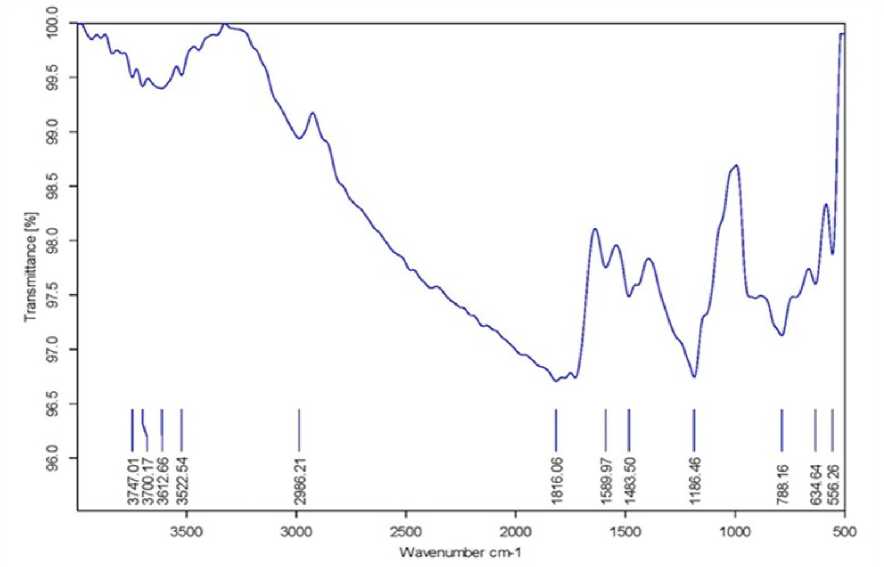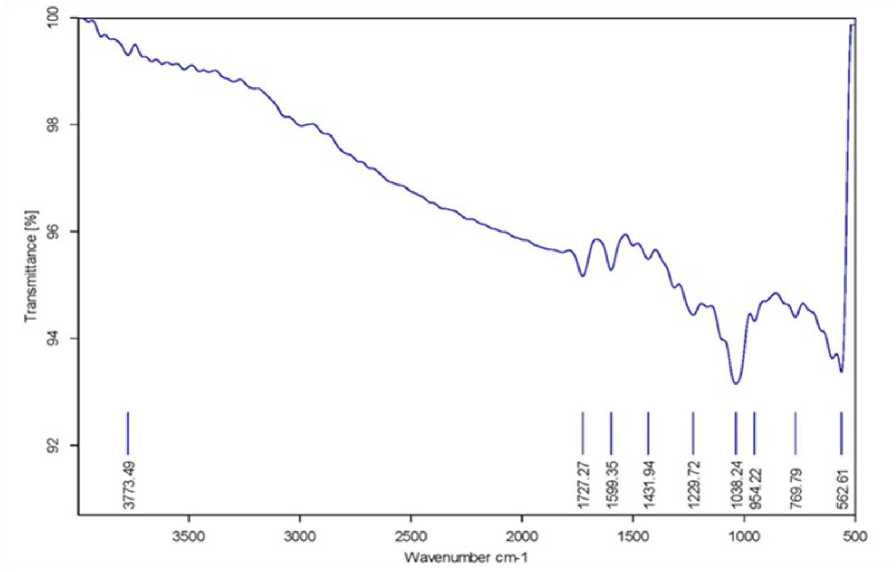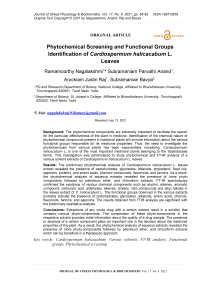Phytochemical Screening and Functional Groups Identification of Cardiospermum halicacabum L. Leaves
Автор: Ramamoorthy Nagalakshmi, Subramaniam Parvathi Anand, Arockiam Justin Raj, Subramanian Bavya
Журнал: Журнал стресс-физиологии и биохимии @jspb
Статья в выпуске: 4 т.16, 2021 года.
Бесплатный доступ
Background: The phytochemical components are extremely important to facilitate the search for the particular effectiveness of the plant in medicine. Identification of the chemical nature of phytochemical compounds present in medicinal plants will provide information about the various functional groups responsible for its medicinal properties. Thus, the need to investigate the phytochemicals from various plants has been exponentially increasing. Cardiospermum halicacabum L. is one of the most important medicinal plants belonging to the Sapindaceae family. This investigation was administered to study phytochemical and FT-IR analysis of a various solvent extracts of Cardiospermum halicacabum L. leaves. Results: The preliminary phytochemical analysis of Cardiospermum halicacabum L. leaves extract revealed the presence of carbohydrates, glycosides, alkaloids, phytosterol, fixed oils, saponins, proteins, and amino acids, phenolic compounds, flavonoids, and tannins. As a result, the phytochemical analysis of aqueous extracts revealed the presence of more phyto components followed by petroleum ether, and chloroform extracts. FT-IR spectroscopy confirmed the existence of various chemical components such as alcohol, alkanes, aromatic compound, carboxylic acid, aldehydes, alkenes, amides, nitro compounds and alkyl halides in the leaves extract of C. halicacabum L. The functional groups observed in the various extracts probably indicate the presence of carbohydrates, glycosides, alkaloids, amino acids, phenols, flavonoids, tannins, and saponins. The results obtained from FTIR analysis are significant with the preliminary qualitative analysis. Conclusions: Extractions of any crude drug with a certain solvent result in a solution that contains various phyto-components. The composition of these phyto-components in the respective solvent provides initial information about the quality of a drug sample. The presence or absence of a certain component plays an important role in the decision about the medicinal properties of the plant. As a result, the phytochemical analysis of aqueous extracts revealed the presence of more phyto-components followed by petroleum ether, and chloroform extracts which can be beneficial in a therapeutic approach.
Cardiospermum halicacabum, Various solvents, FT-IR analysis, Functional groups, Phytochemical screening
Короткий адрес: https://sciup.org/143178317
IDR: 143178317
Текст научной статьи Phytochemical Screening and Functional Groups Identification of Cardiospermum halicacabum L. Leaves
Today, in this modern world highly effective synthetic drugs are readily available but have a long list of possible bad side effects. Because of this, many people rely on herbal medicines which can provide new inputs into the drug development strategy. Herbal medicine is based on traditional medicine and exists all over the world. Each of these traditional medicines has its origin and a private basic philosophy (Vogel, 2003). India is one of the countries with the greatest medical and cultural diversity in the world (Archna Sharma et al ., 2013). Herbal medicines are on the advance in developing countries, and herbal medicines are now firmly established in medical care (Mukerjee and Verpoorte, 2003).
The medicinal properties of any plant are due to the presence of a variety of secondary metabolites in them. Phytochemicals are naturally found in medicinal plants in all the parts namely, leaves, stems, and roots which play an important role in curing diseases. The phytochemical components are extremely important to facilitate the search for the particular effectiveness of the plant in medicine. Thus, the need to investigate the phytochemicals from various plants has been exponentially increasing.
Fourier transform infrared spectroscopy is perhaps the most generally utilized technique for classifying chemical components and has been used in several countries as a necessary method for identifying drugs for the pharmacopeia (Subashini et al ., 2015). FTIR spectroscopy is considered to be a reliable and sensitive method for detecting functional groups in plant extracts, and it has been determined in the IR range of 400-4000 cm-1 (Florence and Jeeva, 2015). This may be the most important and authoritative method to determine the types of chemical groups (functional groups) present in a compound. The wavelength of the fascinated light is a characteristic of the chemical bond which might be seen in the annotated spectrum (Sahayaraja et al ., 2015). Identification of the chemical nature of phytochemicals contained in medicinal plants provides information about the various functional groups responsible for their medicinal properties.
Cardiospermum halicacabum L. is one of the most important medicinal plants of the Sapindaceae family. The local names for this plant are Balloon vine, Puff-ball, Heartseed Vine, Heart pea, Love in a puff (Krishna Murti et al ., 2010). C. halicacabum contains certain phytochemicals that support its role in the medicinal field. It has anti-inflammatory, antidiarrheal, antiparasitic, antipyretic, antifungal, anxiolytic activity, adulticidal activities, urinary tract infections suppression, and antihyperglycemic properties (Asha and Ushpangadan, 1999; Khunkitti et al ., 2000; Selloum et al ., 2003; Sheeba and Asha, 2009; Veeramani et al., 2015). Its chemical constituents are well documented (Harborne, 1998; Deepan et al ., 2012; Sagadevan et al ., 2013; Annadurai et al ., 2013; Mohaddesi et al ., 2016; Vadivazhagi, 2020). The purpose of this study is to use FT-IR analysis to determine the functional groups of various Cardiospermum halicacabum leaf extracts.
MATERIALS AND METHODS
Collection and processing of plant material
Cardiospermum halicacabum L. was collected in February 2021 in Rettaimalai, Tiruchirappalli District, Tamil Nadu, and South India. The collected plants were washed with water to remove soil and dust. The plant material was dried for four to five days in the shade and cut into small pieces, then grind into a coarse powder. The powder was used to extract the active ingredients.
Extraction of the plant material
The coarse powder was placed in the Soxhlet apparatus and extracted successively with various solvents such as aqueous, petroleum ether, and chloroform. The extract was then filtered and evaporated on a rotary evaporator. The dried extracts were stored in the refrigerator for further experiments.
Preliminary phytochemical studies
The leaf extract of various solvents was qualitatively determined for the presence of alkaloids, carbohydrates, glycosides, proteins and free amino acids, fixed oils, phenolic compounds, tannins, flavonoids, saponins, and sterols according to the standard method provided by Harborne, (1998).
FTIR analysis
The Fourier Transform Infrared Spectrophotometer (FTIR) is perhaps the most powerful tool for identifying the different types of chemical bonds (functional groups) present in compounds. The wavelength of the absorbed light is characteristic of the attraction, which can be seen across the entire spectrum. Chemical bonds in a molecule can be determined based on its IR absorption spectrum. Dry powder from various solvent extracts of plant material was utilized for the FTIR examination. 10 mg of the dry extract powder was packed in 100 mg of KBr pellet, to prepare translucent sample disks. The powder sample was placed in a Fourier transform IR spectroscope (PERKIN ELMER, IR) with a scanning range from 400 to 4000 cm -1 with a resolution of 4 cm -1.
RESULTS
Preliminary phytochemical studies
Preliminary phytochemical screening of the C. halicacabum leaf extract of various solvents (aqueous, petroleum ether, and chloroform) presented in Table 1. The preliminary phytochemical analysis of aqueous leaf extract revealed the presence of seven compounds i.e. carbohydrates, glycosides, alkaloids, fixed oils, saponins, phenolic compounds, tannins, and absence of phytosterols, proteins, and flavonoids. Petroleum ether leaf extract revealed the presence of 6 compounds i.e. carbohydrates, glycosides, phytosterol, saponins, proteins, and flavonoids. Preliminary phytochemical analysis of Chloroform and extract revealed the presence of 3 compounds such as alkaloids, fixed oils, and saponins.

Figure 1. FT-IR spectrum of aqueous extract of C. halicacabum L.

Figure 2. FT-IR spectrum of petroleum ether extract of C. halicacabum L.

Figure 3. FT-IR spectrum of chloroform extract of C. halicacabum L.
Table 1 Preliminary phytochemical screening of C. halicacabum leaf extract
|
S.No |
Components |
Aqueous |
Petroleum ether |
Chloroform |
|
1 |
Carbohydrates |
+ |
+ |
- |
|
2 |
Glycosides |
+ |
+ |
- |
|
3 |
Alkaloids |
+ |
- |
+ |
|
4 |
Phytosterol |
- |
+ |
- |
|
5 |
Fixed oils |
+ |
- |
+ |
|
6 |
Saponins |
+ |
+ |
+ |
|
7 |
Proteins and amino acids |
- |
+ |
- |
|
8 |
Phenolic compounds |
+ |
- |
- |
|
9 |
Flavonoids |
- |
+ |
- |
|
10 |
Tannins |
+ |
- |
- |
(+) = Present and (-) = Absent
Table 2 FT-IR frequency range and functional groups of aqueous extract of C. halicacabum
|
Frequency range |
Molecular motion |
Functional group |
|
3947.94 - 3828.20 |
O-H Non-bonded |
Hydroxyl group |
|
3470.03 |
O-H stretch |
Alcohols |
|
3322.41 |
N-H stretch |
Amines |
|
2921.44 |
C-H stretch |
Alkanes |
|
1732.01 |
C-H stretch |
Aldehydes |
|
1611.60 |
C=C stretch |
Aromatic compounds |
|
1373.52 - 1319.73 |
NO2 stretch |
Nitro compounds |
|
1241.32 - 1028.61 |
C-F stretch |
Alkyl & Aryl halides |
|
772.32 |
C-H-Plane bend |
Alkenes & Aromatics |
|
655.52 |
C-Br stretch |
Alkyl & Aryl halides |
|
595.10 - 529.44 |
C-CI stretch |
Alkyl & Aryl halides |
Table 3 FT-IR frequency range and functional groups of petroleum ether extract of C. halicacabum
|
Frequency range |
Molecular motion |
Functional group |
|
3747.01 - 3612.66 |
O-H Non-bonded |
Hydroxyl group |
|
3522.54 |
O-H stretch |
Alcohols |
|
2986.21 |
C-H stretch |
Alkanes |
|
1816.06 |
C-H stretch |
Aldehydes |
|
1589.97 -1483.50 |
C=C stretch |
Aromatic compounds |
|
1186.46 |
C-F stretch |
Alkyl & Aryl halides |
|
788.16 |
C-H-Plane bend |
Alkenes & Aromatics |
|
634.64 |
C-Br stretch |
Alkyl & Aryl halides |
|
556.26 |
C-I stretch |
Alkyl & Aryl halides |
Table 4 FT-IR frequency range and functional groups of chloroform extract of C. halicacabum
|
Frequency range |
Molecular motion |
Functional group |
|
3773.49 |
O-H Non-bonded |
Hydroxyl group |
|
1727.27 |
C=O stretch |
Carboxylic acids |
|
1599.35 |
C=C stretch |
Aromatic compounds |
|
1431.94 |
C-H stretch |
Alkenes |
|
1229.72 - 1038.24 |
C-F stretch |
Alkyl & Aryl halides |
|
954.22 |
=C-H bend |
Alkenes |
|
769.79 |
C-H-Plane bend |
Alkenes & Aromatics |
|
562.61 |
C-Cl stretch |
Alkyl & Aryl halides |
FTIR spectral data interpretation
The FTIR spectrum is used to determine the functional groups of the active components present in the extract based on the spectrum values in the region of IR radiation (Mohrig et al ., 2006; Ashokkumar and Ramaswamy, 2014; Nandiyanto et al ., 2019). The FTIR spectrum of plant extracts (prepared in various solvents) of C. halicacabum was given in Fig 1 – 3. Data on the peak value and potential of functional groups obtained by Fourier-infrared spectroscopy-analysis of the presence in plant extracts (prepared in aqueous, petroleum ether, and chloroform) were presented in Tables 2 to 4. The FTIR spectrum results showed that the aqueous leaf extract having the presence of hydroxyl group, alcohols, amines, alkanes aldehydes, alkenes, aromatic compounds, nitro compounds, alkyl, and aryl halides which shows major peaks from 529.44 - 3947.94 respectively. Chloroform extract having the presence of hydroxyl group, carboxylic acids, alkenes, aromatic compounds, alkyl, and aryl halides which shows major peaks from 562.61- 3773.49 respectively. The spectrum of petroleum ether extract indicated the presence of hydroxyl group, alcohols, aldehydes, alkanes, alkenes, aromatic compounds, alkyl, and aryl halides which shows major peaks at 556.26 - 3747.01 respectively.
DISCUSSION
The extractions of any crude with a specific solvent create a solution that contains various phytocomponents. The composition of these phytocomponents in the respective solvent can be a means of providing preliminary information about the quality of a particular drug sample. The presence or absence of a particular component plays an important role in deciding the medicinal property of the plant extract. As a result, phytochemical analysis of the aqueous extracts showed the presence of more phytocomponents, followed by petroleum ether, and chloroform extracts. Alcoholic and aqueous extracts of C. halicacabum L. contain tannins, flavonoids, saponins, sterols, and triterpenes (Venkat Rao et al., 2006; Kurian, 1995). Parameshappa et al., (2012) reported that petroleum ether extract of the plant contains sterols, carbohydrates, flavonoids, and triterpenes; Chloroform extract contains alkaloids, coumarin, flavones, quinones, saponins, steroids, and tannins (Aishwarya et al., 2014).
The results of FT-IR spectroscopy confirm the presence of various chemical components such as alcohol, alkanes, aromatic compound, carboxylic acid, aldehydes, alkenes, amides, nitro compounds, and alkyl halides in the extract of C. halicacabum L. leaves (Viji et al ., 2010). This result agrees with the result of Prabakaran et al ., (2014). FT-IR analysis of the extract from methanolic leaves of C. halicacabum shows the presence of alcohol, isocyanides, alkyl compounds, alkanes, and components containing chlorine (Sabeerali et al. , 2018; Mohammed Junaid et al. , 2020). The functional groups observed in the various extracts likely indicate the presence of carbohydrates, glycosides, alkaloids, amino acids, phenols, flavonoids, tannins, and saponins. The consequences of the FTIR evaluation are considerable for the preliminary qualitative investigation.
ACKNOWLEDGEMENT
The authors gratefully acknowledge PG and Research Department of Botany, National College, providing the infrastructure and other facilities. All the authors wish to acknowledge the National College Instrumental Facility (NCIF), National College (Autonomous), Tiruchirappalli for their support and guidance during the FT-IR analysis.
CONFLICTS OF INTEREST
The authors declare that they have no potential conflicts of interest.
Список литературы Phytochemical Screening and Functional Groups Identification of Cardiospermum halicacabum L. Leaves
- Aishwarya V., Sheik abdulla S., Dheeba B., Renuka R. (2014) In vitro antioxidant and anticancer activity of Cardiospermum halicacabum L. Against eac cell line. Int. J. Pharm. Sci., 6(8), 263-268.
- Annadurai A., Elangovan V., Velmurugan S., Ravi Kumar R. (2013) Preliminary phytochemical screening and antibacterial of Cardiospermum halicacabum L. Pelagia Research Library., 4(5), 302-308.
- Archna Sharma R.A., Sharma, Hemlata Singh. (2013) Phytochemical and Pharmacological Profile of Abutilon indicum L. Sweet: A Review. Int. J. Pharma. Sci. Rev and Res., 20, 20-127.
- Asha V.V. and Ushpangadan P. (1999) Antipyretic activity of Cardiospermum halicacabum. Indian J. Exp. Biol., 37(4), 411-414.
- Ashokkumar R.M. and Ramswamy (2014) Phytochemical screening by FTIR spectroscopic analysis of leaf extracts of selected Indian Medicinal plants. Int. J. Curr. Microbiol. App. Sci., 3(1), 395-406.
- Deepan T., Alekhya V., Saravanakumar P., Dhanaraju M.D. (2012) Phytochemical and Anti-Microbial Studies on the Leaves Extracts of Cardiospermum halicacabum Linn. Adv. Biol. Res., 6(1), 14-18.
- Florence A. R. and Jeeva S. (2015) FTIR and GC-MS spectral analysis of Gmelina asiatica L. Leaves. Science Research Reporter. 5(2), 125-136.
- Harborne J. B. (1998) Phytochemical methods. In A guide to modern techniques of plant analysis 3 rd ed. London, Chapman and Hall, pp. 40-137.
- Khunkitti W., Fujimaki Y. and Aoki Y. (2000) In vitro antifilarial activity of extracts of the medicinal plant Cardiospermum halicacabum against Brugiapahangi. J. Helminthol., 74(3), 241-246.
- Krishna Murti Mayank A., Panchal, Vijay L., Gajera V. (2010) Pharmacological properties of C.halicacabum - A review. Pharmacology. 2, 1005.
- Kurian J.C. (1995) Plants that heal. Pune: Oriental Watchman Publishing House.
- Mohaddesi B., Dudhrejiya A. and Chauhan M. (2016) Pharmacognostical and physicochemical evaluations of Cardiospermum halicacabum L. seeds. Res. J. of Pharmacog., 3(1), 35-41.
- Mohammed Junaid H. D., Sathish Kumar K., Darul Raiyaan G.I., Mohamed Khalith S.B., Sundarapandian S., Kantha Deivi A. (2020) Effect of Solvents on Phytochemical Composition and Antioxidant Activity of Cardiospermum halicacabum (L.) Extracts. Pharmacogn J. 12(6), 1241-1251.
- Mohrig J.R., Hammond C.N. and Schatz P.F. (2006) "Infrared Spectroscopy" in Techniques in Organic Chemistry. Freeman: New York,
- Mukerjee P.K. and Verpoorte R. (2003) 'In GMP for Botanicals; Regulatory and Quality issues on phytomedicines' 1.
- Nandiyanto B.D., Oktiani R. and Ragadhita R. (2019) How to Read and Interpret FTIR Spectroscopy of Organic Material. Indo. J. of Sci & Technol., 4(1), 97-118.
- Parameshappa B., Sultan A.B., Sen S., Chakraborty R., Vinod K.G., Vidya S.G., Sowmya L., Raju K.K., Sesh K.P.K.R., Lakshmi A.V.S.M. (2012) Acetaminophen-induced nephrotoxicity in rats: Protective role of Cardiospermum halicacabum. 50(2), 247-253.
- Prabakaran S., Pugazhendy K. and Revathi A. (2014) Phytochemical investigation and functional group screening of Cardiospermum halicacabum and Pisonia alba by FT-IR spectroscopic analysis. Int. J. mod. res. rev., 2(9), 282-286.
- Sabeerali A., Selvarasuvasuki M. and Ganapathy Murugan A.L. (2018) Identification of biological components from potential bone healer medicinal plants. J. drug deliv. Ther., 8(3), 32-41.
- Sagadevan P., Suresh S.N., Rathish Kumar S., Gayathri S., Vithya E. (2013) Anti-cancer activity of methanolic leaf extracts of Andrographis paniculata (Nees) and Cardiospermum halicacabum L against human breast cancer cell line. Int. J. of Pharm & Life sci., 4(9), 2983-2986.
- Sahayaraja P.A., Gowri J., Dharmalingama V., Shobanaa R., Angelin Premab A.A. (2015) Phytochemical screening by FTIR spectroscopic analysis of leaf and stem extracts of Wedelia biflora. Int. j. nano corros. sci. eng., 2(5), 322334.
- Selloum L., Bouriche H., Tigrine C., Boudoukha C. (2003) Anti-inflammatory effect of rutin on rat paw edema, and on neutrophils chemotaxis and degranulation. Exp. Toxicol Pathol 54(4), 313318.
- Sheeba M.S. and Asha V.V. (2009) Cardiospermum halicacabum ethanol extract inhibits LPS induced COX-2, TNF, and iNOS expression, which is mediated by NF-B regulation, in RAW264.7 cells. J. Ethnopharmacol., 124(1), 39-44.
- Subashini M.S., Rajendran P., Ashok G., Kanthesh B.M. (2015) TLC, FTIR and GCMS analysis of leaves of Gymnema sylvestre R.Br from Kolli Hills, Tamil Nadu, India. Int. J. Curr. Microbiol. App. Sci., 4(7), 757-764.
- Vadivazhagi M.K. (2020) Anti-oxidation and Antimicrobial efficiency of Cardiospermum halicacabum leaf. A Journal of Composition Theory. 834-847.
- Veeramani C., Al-Numaira S., Chandramohana G., Alsaifa A., Pugalendi K.V. (2015) Influence of Cardiospermum halicacabum leaf extract on membrane-bound ATPases in streptozotocin-induced diabetic rat. Afr. J. Tradit. Complement. Altern. Med., 12(3), 68-74.
- Venkat Rao N., Chandra Prakash K. and Shanta Kumar S.M. (2006) Pharmacological investigation of Cardiospermum halicacabum (Linn) in different animal models of diarrhea. Research paper. 38(5), 346-349.
- Viji M. and Murugesan S. (2010) Phytochemical Analysis and Antibacterial Activity of Medicinal Plant Cardiospermum halicacabum Linn. Journal of Phytology.
- Vogel G.H. (2003) Drug discovery and evaluation. Pharmacological assays 202.


